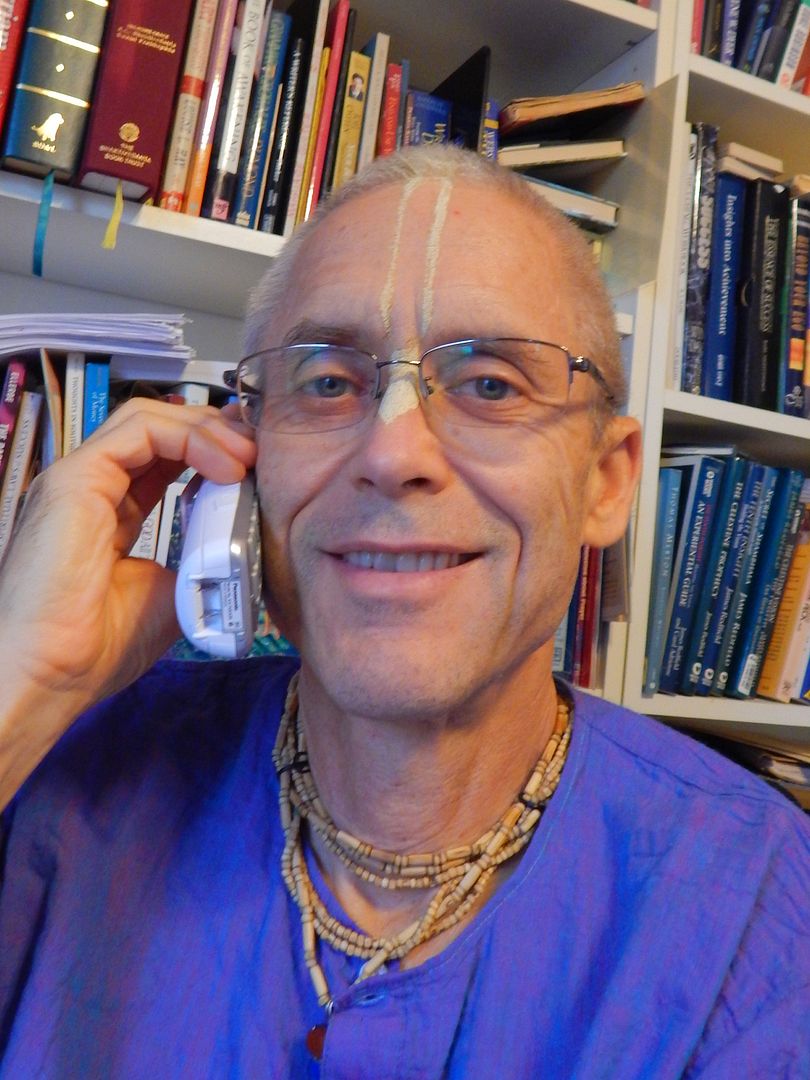Gita verse-by-verse study Podcast
Download by “right-click and save content”
The post Gita 09.10 – Nature is not causally complete without an ultimate cause appeared first on The Spiritual Scientist.
Websites from the ISKCON Universe
Gita verse-by-verse study Podcast
Download by “right-click and save content”
The post Gita 09.10 – Nature is not causally complete without an ultimate cause appeared first on The Spiritual Scientist.
 Our dear 4th grader, Rasalila Shinde, has recently participated in a national “I Spy Kindness” writing contest and won first prize for the 3rd – 5th grade category. She wrote an essay describing acts of kindness she has witnessed and experienced in her life.
Our dear 4th grader, Rasalila Shinde, has recently participated in a national “I Spy Kindness” writing contest and won first prize for the 3rd – 5th grade category. She wrote an essay describing acts of kindness she has witnessed and experienced in her life.
The “Be Kind People Project” wrote: “Her essay stood out because of her ability to see kindness in the smallest action (helping ducklings cross the street), to a global response (fundraising for flooding in Mayapur, India). It is clear that Rasalila sees kindness as an empathetic choice rather than a decision worthy of reward or praise. She gives me great hope for the future.”
We warmly congratulate her for her accomplishment. Well done!

Some spiritual practitioners think that now they have achieved some reasonable control of the physical sex urge, they are well nigh up there in the wispy clouds of victorious abstinence, deserving of respect and honour. Wrong! Congratulations on becoming a decent human being. Welcome to the world of subtle selfishness.
By Kesava Krsna Dasa
Srila Prabhupada states: ‘Illicit sex is the most prominent sin due to lusty desire.’ (SB 5.14.22 purport) This is because it is sometimes called ‘ adi-rasa ‘ the primeval, original pleasure, which sadly for us, is a twisted iron-like perversion enjoyed separately from Krishna. With a little enlightenment some people can see the problems arising from lust, but; ‘The conditioned soul sometimes personally appreciate the futility of sense enjoyment in the material world, and he sometimes considers material enjoyment to be full of miseries. However, due to his strong bodily conception, his memory is destroyed, and again and again he runs after material enjoyment, just as an animal runs after a mirage in the desert.’ (SB 5.4.10)
Whenever Srila Prabhupada uses the words ‘sense gratification,’ it is another way of saying self-gratification, or satisfaction of the self. Our own nitya-baddha selfish pursuits will hopefully end in Krishna consciousness. ‘The background for the devotee is the all-good Himself. Why should the devotee aspire for something good for himself? A Krishna bhakta has no desire for his own personal benefit.’
(CC Madhya 19.149 purport)
Such a high ideal has to be attained if any devotee wishes to progress without limit. Having ‘girdled the loins’ for celibacy, a host of challenges will confront us. The subtle realm of the stubborn mind, intelligence, and ego will present a myriad of contemplative opportunities to slacken our resolve, and lead us downwards to physical puzzlement. ‘The senses, the mind, and the intelligence are the sitting places of this lust. Through them lust covers the real knowledge of the living entity and bewilders him.’ (BG 3.40)
While celibacy is a basic human quality, many practitioners develop an inordinate fixation on trying to control the sexual urge. This will happen if our decision to become celibate was done in haste, out of frustration, or simply overestimating the ability to control lust. This can be compared to sleeping on the floor because the bed is broken. Srila Bhaktisiddhanta explains, ‘When an impersonalist or illusionist shows off his renunciation in the material world, he simply exposes himself in anger or deep attachment with the object of apparent renunciation. He would have continued to enjoy those objects if they were of no trouble to him.’
(Upakhyane Upadesa)
Many other devotees would have learnt, ”.nor by renunciation alone can one attain perfection’. (BG 3.4) and so heeded the advice of the Lord in the summation of the third chapter of Bhagavad-Gita, ”.and thus ‘ by spiritual strength ‘ conquer this insatiable enemy known as lust.’ (3.43) by chanting sincerely and associating with serious devotees, we should be able to remain celibate. This is the easy part. If one feels heroic for being celibate, his sense of achievement may get quickly undone when more culturally refined and subtle forms of lust appear, from deep inside the psyche.
So what is subtle sex? Is this something that only afflicts devotees? Is it difficult to overcome?
Srila Prabhupada’s observation of certain sporting activities led him to make this interesting comment in (SB 3.35.20 purport) ‘Sometimes the demoniac arrange for so-called sports like tennis, with the opposite sex. The purpose of such sporting is to see the bodily construction of the beautiful girl and enjoy a subtle sex mentality.’ We can well imagine this scene repeated in other sports like gymnastics and so on, where decent officials and the public might admire things other than the contest itself.
In matters of sexual crimes, a study of case histories will reveal how most perpetrators cannot explain the impulse, which led them to commit perverted crimes, when asked by a psychologist or other professional. Yet it is lust, which fuels their delusional fantasies, which begin as contemplation, then fulfilled in gruesome and peculiar ways. (BG 2.62-63)
A spiritual practitioner can also do abnormal things impelled by lust, yet give the impression that such behaviour is quite normal. If one thinks, he is amongst star-struck and immature devotees who would hardly notice his transgressions, or look the other way for fear of committing offences, such misleading indecency is naked subtle sex in action. If one is in a position of authority, he can manoeuvre things managerially to get as close as possible to the object of contemplation, all the while appearing as a staunch renouncer. It should not be discounted that similar fantasies can be met from the sacred asana, during kirtana, or any other sphere of devotion. ‘Many devotees fall down due to illicit sex. They may steal money and even fall down from the highly honoured renounced order. Then for a livelihood they accept menial services and become beggars.’ (SB 5.14.22 purport)
We have a culture of giving tribute to certain positions held. In theory it means that unqualified persons can occupy the post and still be highly praised, which is an imbalanced approach in light of the following verse. ‘On the other hand, if a sincere person tries to control the active senses by the mind and begins karma-yoga
(in Krishna consciousness) without attachment, he is by far superior.’ (BG 3.7) This means that a so-called lowly grhastha who earns an honest living, is superior to one of higher standing who is grappling with celibacy issues, or is a pretender.
On the spiritual frontier, if controlling the physical sexual urge is supposed to be the easy part, then how is subtle sex more difficult to overcome? It is no coincidence that one has to be more advanced spiritually, to slowly dissolve the subtle remains of lust and selfish desire, which are rooted in the false ego, the most formidable element to deal with. Can we ever wonder why Srila Prabhupada repeatedly stressed that we are not the body, or in this case, not this egotistical identity’?The Supreme Personality of Godhead said: O Partha, when a man gives up all varieties of desire for sense gratification, which arise from mental concoction, and when his mind, thus purified, finds satisfaction in the self alone, then he is said to be in pure transcendental consciousness.’ (BG 2.55)
For a devotee, subtle sex means dealing with numerous mental concoctions or various forms of selfish desires. If one finds celibacy to be a dreary affair, he will try to compensate the lack with positional advantages to ensure a good dose of pratistha ‘ name, fame, adoration, and distinction. By doing so his flirting may be kept on the subtle level. However, eventually, the curiosity of missed sexual chances will have to manifest on the gross level. When Krishna says, ”.though the taste for sense objects remains.’ (BG 2.59) it can be an absurd situation when faced with how to curb the enemy known as lust. Such speculation will try to keep it hidden from public scrutiny, lest the unimaginable happens. ‘The living entities in this conditioned world are My eternal fragmented parts. Due to conditioned life, they are struggling very hard with the six senses, which include the mind.’ (BG 15.7)
Subtle sex also means to think oneself as important, a big devotee, a celebrity, as learned and other larger than life caricatures, which can border on the delusional or bewilderment plane, depending on how much memory and intelligence has been eroded by lust, or selfish desire. The bottom line is, whenever we display lust or selfishness, it is a symptom of envy towards Krishna, and by implication, to other living entities and devotees. ‘But those who out of envy, do not regularly follow these teachings are to be considered bereft of all knowledge, befooled, and ruined in their endeavours for perfection.’ (BG 3.22)
Most of us are trying to follow these teachings however, but it seems highly improbable to ever overcome envious and perverted adi-rasa. What can be done?
We firstly should not be judgemental of other devotees who struggle with the senses.
Their undertaking is indeed a heroic one. We may not understand why such devotees come to join Krishna consciousness due to some mystical intrigue by the Lord. ‘The Lord understands the devotee who hesitates to engage in the Lord’s service, not knowing whether he should again try to revive his material life. After repeated attempts and failures, he fully surrenders to the lotus feet of the Lord.’ (SB
5.14.10 purport)
Considering our own selves to be envious of Krishna, we have to be convinced it is a very unhealthy state of affairs. If we feel strongly enough it can propel us to be enthusiastic with self-exertion. Some self-effort is required to obtain some mercy.
‘But a person free from all attachment and aversion and is able to control his senses through regulative principles of freedom can obtain the complete mercy of the Lord.’ (BG 2.64)
This mercy should translate into spiritual strength required to surmount formidable obstacles. Through the mercy of the guru, we have to gain spiritual strength. Moving forward, the inflexible mind aided by lust and false ego will present ludicrous excuses not to continue. In effect, we are transforming our existence from false to real. ‘We may sometimes be absorbed in some thought which is sinful, but if we give up the sinful thought, it may be said that we give up the body.’ (SB 3.20.28 purport)
While pushing forward and chanting earnestly, the scoundrel mind will remind us, ‘Are you really getting anywhere with your laborious efforts? Slow down. Be balanced and stop being fanatical! There’s always another time to get serious. I promise I’ll help you then.’ Such semi-naked subtle sexual overtures will try to slow the pace and make our envy of Krishna a cosy bed of roses. Time and time again we will get these comforting reminders, which can make us feel that attaining perfection is impossible. We are almost correct thinking like this. Srila Ramananda Raya says, ‘There is an inexplicable fact about the natural inclination of the gopis. The gopis never want to enjoy themselves with Krishna personally.’ (CC Madhya 8.207)
This should be the basis of our sincere efforts to advance in Krishna consciousness.
We literally have to do the inexplicable, and change our motives from cute, cuddly envy, to those pleasing to Sri Sri Guru and Gauranga. The unlimitedly powerful holy names can do inexplicable wonders with ease and extricate our false identity. ‘Therefore Chaitanya Mahaprabhu says here, Krsna-bhakta niskama. Since the Krishna bhakta, the devotee of Krishna, is satisfied with Krishna, there is no possibility of a falldown.’ 9CC Madhya 19.149 purport)
Ys, Kesava Krsna dasa.

By Urmila Devi Dasi
Can we make our children turn out the way we want?
Srila Prabhupada once said, “If you place a child in good association, he will act properly, and if you place him in bad association, he will act improperly. A child has no independence in that sense.… According to Vedic civilization, as soon as a child is four or five years old, he is sent to a gurukula, where he is disciplined.”
Anyone who has worked with children knows they are vulnerable to their environment. Yet children also carry from their previous lives a complex burden of good and bad karma and a particular tendency of character. In fact, the mentality of the parents during conception attracts a particular soul—with particular inclinations—to become their child. Because of this, enlightened parents prepare themselves so that they can be in spiritual consciousness during conception. Thus their child will be receptive to the training they will give him. Srila Prabhupada says, “You can mold the children in any way. They are like soft dough.” So the mold is essential when considering the shape of the final piece of sculpture. But the quality of the material one puts into the mold is also important.
On the other hand, our children’s tendencies from their previous lives and present conceptions can change. Their real personality is spiritual, filled with love for Krishna at every moment. Their natural position is that of eternal knowledge and bliss. Therefore it is entirely reasonable and possible to transcendentally mold anyone, of any previous disposition. After all, the spiritual “mold” is the shape of the real self.
The principle of such molding is quite simple. We need to surround the child with saintly association, eliminating all false and negative concepts. To do so is difficult not because it is unnatural or burdensome, but be-cause modern Western society, saturated with materialism, discourages spiritual growth.
We might feel, though, that we should not “isolate” our child. We might be afraid that our child won’t be able to cope with society if raised in a spiritual atmosphere. Yet we teach our children to eat properly by feeding them healthy food; we don’t give them a taste for junk food to help them cope with supermarket aisles. Nor do we give them small doses of beer or marijuana to help them conquer the urge for intoxication.
So rather than expose our children to materialism, we should train them to become saintly. Then as masters of their mind and senses, they will be happy in all circumstances. And rather than becoming allured by material life, they will create a spiritual atmosphere around themselves that will attract others.
Vedic education’s most important feature is to surround children with teachers and other students who want to know their true self. Such persons live free from lust, greed, and envy and therefore do not eat meat, fish, or eggs, take intoxication, gamble, or have illicit sex. And the true teacher, according to Vedic standards, is one who is absorbed in Krishna, the Absolute Truth. The true teacher does everything for Krishna, doesn’t hanker or lament for material things, and is always in a state of spiritual happiness.
Such a teacher, however, need not neglect the material, academic side of education. We require practical knowledge in this world. Yet we should not want to acquire knowledge simply to build up another false material identity that will disappear in the next death and rebirth. Nor should we want academic knowledge for its own sake, which will also be lost when we change bodies. But when academic knowledge and practical skills are learned in the service of the higher self, the benefit is eternal.
Throughout the world, societies train children to be economically and socially productive members of their culture. They may also learn a religious faith, with its doctrine and rituals. But imagine if some children, even a small group, were molded to be above all material designations, all influences of the material atmosphere. These children could lead mankind into an era of righteousness and harmony.

By Ithamar Theodor
In this paper Ithamar Theodor proposes a model based on Bhagavad-gita and aimed at developing a philosophical basis for social development in ISKCON. Referring to previous studies of ISKCON, he argues that devotees’ self-understanding is often not consistent with the values and principles of Vaisnava culture. In this paper he points out that a moral-religious foundation is the default position for a sustainable spiritual life for the individual and the community.
It is sometimes said that Srila Prabhupada built a house in which the whole world can live. Inspired by this idea, I would like to suggest a three-storey house model as a reflection of the nature of ISKCON. The idea is grounded in the Bhagavad-gita and is designed to offer a supporting framework for the sankirtana movement, as well as to further the ongoing discussions of implementing varnasrama within ISKCON. The house described here has three storeys, each having fundamental distinctions that can best be demonstrated by the differences in ontology and ethics characterising each level. The idea presented here favours an individual-centred, as opposed to an organisation-centred, paradigm. Before addressing the issue, let us acknowledge the two-dimensional realm in which ISKCON exists. Ravindra Svarupa Dasa writes:
… one needs to become acquainted with two contrasting social ideals, or models, transmitted to us by Srila Prabhupada. The first is that of a society of Vaisnavas, of transcendental, liberated devotees who conduct themselves spontaneously in accord with the principles called sanatana-dharma. The second is that of a society of materially conditioned human beings who strictly conduct themselves in obedience to the injunctions of the Vedas under the system called varnasrama-dharma. (Ravindra Svarupa Dasa, pp. 35-6)
This presentation lays a firm foundation for distinguishing the conditioned human realm from the higher spiritual realm and their corresponding ethical systems. In describing the three-storey house, the first floor corresponds to the human level, and the second and third floors correspond to the transcendental level.
First floor: Living in the world
The first floor is worldly, representing proper human life governed by dharma. Within this world, the human being lives a healthy life characterised by morality, law and justice, personal and social order, religion, adherence to duty, etiquette and social stability. The basic social structure derived from dharma is varnasrama, which is inherent in every individual’s nature or state of existence within the three gunas. It stabilises one’s personality and character by providing a supporting framework of duties. Thus, the individual is designated according to two basic parameters: his or her attitude towards renunciation, and his or her professional ability, with every varna and asrama having its own etiquette.
Many individuals living on this floor have a positive view of the world. It is seen as a place where a varnasrama society can and should prosper, its members living moral, productive and happy lives. Such a society is naturally inclined to protect its weaker members, including animals, and foster as well as educate its future generation, encouraging the development of various branches of knowledge, such as architecture, medicine and the arts.
Second floor: The struggle to get free from the world
This floor is fundamentally different from the first floor, and its residents are those who are struggling to free themselves from the cycle of birth and death. The world is no longer viewed as positive, but as a place of misery, wherein repeated birth and death take place. Thus the residents concentrate on two main goals: developing detachment from the world, and establishing a hold in the spiritual realm.
These residents are not obliged to follow dharma, as they have no interest in establishing proper worldly life, although they sometimes do follow the injunctions of dharma as an example to the first-floor residents. Their goal is higher, and the branches of knowledge cultivated by them are such that they see themselves as spirit souls rather than human beings bound by the three modes of nature. Their ethics are different from those of the first- floor residents.
Rather than trying to achieve prosperity in the world, they cultivate indifference towards success and failure. Instead of attempting to protect their society, they aspire to develop indifference to their enemies and their friends. They do not attempt to situate the mind in the mode of goodness, through art, beauty and culture, but seek to detach it from everything material and fix it on the spiritual realm. They perceive the world as dualistic and comprised of two elements that can never blend: matter and spirit. Their aim is to free themselves from matter and reach a plane of pure spiritual existence. They are absorbed in different forms of yoga that have a common aim: to detach the practitioner from the material and connect him to the spiritual.
Third floor: Full spiritual realisation
Here reside those whose struggle is over. They are completely established in the spiritual realm. The material world holds no attraction for them. The nature of their existence is of full spiritual consciousness, spiritual existence and spiritual bliss. Their absorption in love of God is so deep that they see no difference between residing in this world or in the spiritual realm. The pure emotional waves, or rasas, experienced by them have no comparison in the material world. From their point of view, only Lord Krsna, His expansions, His devotees and His service exist. The whole question of matter and spirit, worldly culture and renunciation, seems irrelevant to them. Material knowledge, such as that found in sophisticated cultural pursuits or high philosophy, may be perceived by them as an obstruction to their absorption in ecstasy, and may thus be rejected.
The staircase
So the question now is where do we go from here? We have found three groups of people living in completely different realms, so much so that there may be no common language with which they can communicate, and no common grounds on which they can agree.
Fortunately, this house has a staircase or a ladder connecting the first floor to the second, and the second floor to the third. This idea is best presented by Bhurijana Dasa as the ‘yoga ladder’. (Bhurijana Dasa, pp. 59-68) These steps are an intrinsic part of the house, and they encourage all residents to continuously progress upwards towards the third floor. The stage on which one is situated is determined by the motive underlying his or her actions. For example, one motivated by the fruits of action can aspire to work without attachment for these fruits, or learn to offer them to Krsna. Likewise, one who performs his devotional service while maintaining a strong bodily identification through the performance of karma-yoga, may gradually elevate himself to a more spontaneous platform where he does not need to rely so much on a bodily designation to perform his service. In any case, the principle of constant progress underlies the whole system and may be its most important factor.
As soon as a sincere person is properly situated on a particular stage or floor and follows the proper etiquette, rules and regulations for that stage, he will feel happy in his progress and will strengthen and encourage the other residents, no matter where they are situated. Thus a sincere first-floor, or kanistha, resident would happily associate with a sincere second-floor, or madhyama, renunciate, their common ground being that they both accept the house, its rules and goals, and are trying to make progress from their present position to become third-floor uttama-adhikaris.
The common principle, therefore, is to be properly situated somewhere in the house, to thrive there and endeavour to make constant internal progress towards a higher stage. As soon as these conditions are established, the house could support unlimited residents, all living in harmony with each other. A member of ISKCON could thus be designated a resident of that house, irrespective of whether he lived within or outside the temple, whether he is an advanced devotee or a neophyte. The only qualifications for residence are his acceptance of the ethical obligations and duties appropriate to his position and a sincere endeavour to make progress.
Srila Prabhupada, who was situated on the highest level of love of God, or the third floor, raised, by his personal association, all those who came into contact with him. Indeed, ISKCON was established on the second and third floors. In other words, devotees could experience the deep renunciation and transcendental emotions of love of God during Prabhupada’s presence, and also after his departure.
Endeavouring to implement Krsna consciousness in the Western world, Srila Prabhupada began by establishing the third floor, i.e. chanting of the Hare Krsna maha-mantra, and later introduced the second floor, through preaching that the material world is a miserable place which is to be renounced. Although his books contain ample instructions on laying the foundations of the first floor, it seems this part of his mission remained unfulfilled. (See Ravindra Svarupa Dasa, 1999)
After Prabhupada’s departure, ISKCON perceived itself as a society of second- and third-floor residents, considering the first floor a compromise for those souls who were unable to be fully Krsna conscious. These individuals were considered second-class devotees, known by various titles such as ‘Friends of Krsna’ or ‘congregation members’. The common view of a second- and third-floor devotee was someone who was living within a temple, chanting sixteen rounds, following the four regulative principles, and who was situated on the transcendental plane, beyond the three modes of nature. With such prevailing ideas it was no surprise that organised missionary activities were at their peak, whereas community projects such as education, culture, social development and professional devotee businesses (as opposed to unprofessional missionary activities designed to raise funds) were neglected. ISKCON continued to function with these assumptions long after Prabhupada’s disappearance, and although there have been significant accomplishments in many areas, there is a growing feeling of dissatisfaction among many members due to shortcomings in social and educational development; or, according to our model, due to the first floor not being properly or sufficiently maintained. Thus writes Dr E. Burke Rochford:
There is a striking lack of trust between ISKCON members and the movement’s leadership, as well as between devotees themselves. … there is a lack of honest and open communication between devotees. … ISKCON has generally failed to integrate families and family life into its communities. Until recent discussions of ‘social development’, ISKCON has done little towards building an internal domestic culture capable of supporting householders and their children. … A lack of employment opportunities within ISKCON … . Inadequate educational alternatives within ISKCON … . (Rochford, p. 17)
I would thus suggest that ISKCON urgently needs to heal itself and to firmly establish its first floor, thus allowing each and every member to make the best use of his energy and qualifications.
How can this structure be practically applied? Should we gather all ISKCON members and divide the assembly into three groups, saying: ‘All those who belong to the first floor, please assemble over here.’ This is obviously not desirable, helpful or possible, as the constant interaction between the three groups is beneficial for all. Moreover, the personality of most devotees may reflect all three floors to various degrees. For example, a person may take care of his health (first floor), contemplate how he is not the body (second floor) and on visiting the Deities, may experience ecstasy and love of God (third floor). It is not the members that should be separated from each other, but the floors.
Each floor has its own distinct ethos, finding its expression in different ideas, modes of behaviour, underlying assumptions, language, and so on. In other words, this three-storey model is a theoretical structure, similar to a grammatical paradigm presenting fictional forms such as roots and stems, which although not applied in the daily usage of a language, serve as its foundation.
It is my conviction that the obscure blending of these floors is preventing ISKCON from realising its true potential, and that by mentally organising and separating the floors, ISKCON as a society would make greater progress towards fulfilling the role designed for it by Srila Prabhupada, which is to become a ‘cultural movement for the benefit of all’. (Prabhupada, p. 24)
I have a practical example of a person who has developed all three floors in his life; a devotee friend who exemplifies a perfect balance of all three storeys. His asrama is organised and clear; he is steadily married and living happily with his wife and children. His varna is well-organised; he is a professional, greatly respected at the firm where he works, and receives adequate remuneration. Being inspired in his Krsna consciousness, he manages a flourishing temple with high standards of Deity worship, and ample preaching programmes. His sannyasi guru is very pleased with him and relies on his considerable efforts. Being fully engaged, he is already contemplating the next asrama, hoping, in due course, to delegate his temple responsibilities and devote time to travelling and preaching. Belonging to all three floors, he understands the difference between them and is thus able to constantly move between them.
The organisation and the individual
Let us examine the issue in terms of the organisation (ISKCON) and the individual. ISKCON was established by Srila Prabhupada as an army of preachers whose main objective was to spread Krsna consciousness and fight maya (illusion). The heart of that concept is undoubtedly the spreading of Sri Caitanya Mahaprabhu’s sankirtana movement, which required considerable organisation. The mission was inherited by Srila Prabhupada, who delegated the responsibility to ISKCON’s Governing Body Commission (GBC), who in turn passed it down to the temple presidents, and so on. Krsna Dharma Dasa writes:
Srila Prabhupada also gave some directions as to how the GBC should function. ‘To map out a global preaching strategy for the worldwide society, while leaving details of local preaching to the local management’. (Krsna Dharma Dasa, p. 71)
Within that structure, as in the regular army, everyone’s attention is directed upward to the generals, waiting for them to define the tasks. Once this has been done, responsibility is delegated to a lower executive level to devise a plan and perform the task. This was certainly the best paradigm for establishing a new movement, engaging divisions of young and inspired men and women, and may remain so for many highly motivated devotees. However, it tends to sacrifice individual needs to the higher cause, justifying the sacrifice of the individual as the price of participating in the sacred mission. Thus, ‘Preaching is the essence, books are the basis, purity is the force and utility is the principle.’ No doubt, this idea is firmly grounded in the Bhagavad-gita, where Krsna says, ‘For one who explains this supreme secret to the devotees, pure devotional service is guaranteed, and at the end he will come back to Me.’ (Bhagavad-gita 18.68) However, the Bhagavad-gita is also unique in its emphasis on individual development and, in fact, the whole Gita is spoken for Arjuna’s benefit, showing him how, from every point of view, serving Krsna (through fighting the war) is in his own best interests.
The three-storey house is ‘individual-centred’, in that its point of departure is not the greater mission but the individual. In other words, for someone to define himself in that paradigm, he would have to start by examining, deeply and honestly, his own nature and his own state of spiritual advancement. Having done so, he could find his best situation or position in the model, stick to the rules of that position and make gradual progress at his own pace. For example, if a person defines himself as a grhastha, he would follow the principle of taking care of his wife and children. It appears then, that the definition of asrama is quite clear. However, the question of varna needs further clarification, as Urmila Dasi explains:
If we understand personality through the models presented in the Bhagavad-gita, the corresponding vocational direction becomes easier, as in that model personal qualities and work are closely entwined. In loose terms, those with brahminical qualities work as priests, in the teaching professions and as government advisors. Ksatriyas work in government administration and serve in the military. Vaisyas have work related to farming, business and trade. And sudras work in manual labour, entertainment, crafts and as general assistants to the other three types in society. (Urmila Dasi, p. 24)
It seems that one can define his nature, more or less, in terms of varna, and then project this according to present time and circumstance. In other words, if one is inclined towards business, he or she could be defined as having a vaisya nature, even though they would not necessarily exemplify the traditional vaisya characteristics, such as farming. Similarly, if one is inclined towards studying and teaching, he or she could be considered as having a brahminical nature, even though they may find themselves in a Western university and not in a hut on the banks of the Sarasvati River. Having said that, it follows that a different ethical code would be appropriate for each varna. For example, brahmanas should be austere, honest and learned, whereas ksatriyas should be courageous and generous.
The discussion of varnasrama has been taking place in ISKCON for many years now. A major objection to implementing this system is that ‘ISKCON is meant for more than good marriages.’ The argument is that ISKCON is a great spiritual movement, whose aim is to liberate its members from the world of samsara, not to arrange a comfortable material situation for them. However, the three-storey house paradigm uses varnasrama as a point of departure for spiritual life and as a supporting framework for the sankirtana mission, as opposed to perverted varnasrama forms, which promote different types of caste consciousness while ignoring the true spiritual goal.
The basic assumption of the three-storey-house model is that when one’s psycho-physical nature is properly regarded, then one’s energy for material and spiritual life is revived. A well-organised first floor creates the right atmosphere for developing the second and third floors. Conversely, a poorly developed first floor is a fertile ground for social unrest and even vaisnava-aparadha.
Where does the GBC fit into this framework? Are we proposing a ‘do-it-yourself’ system, where each individual can ascertain his own situation? To a small extent, yes, but in a way that will bring the members together willingly, as opposed to being forcibly controlled.
What is gained by applying such a structure? The graduates of a healthy first floor become steady residents of the second, who are then gradually established on the third. The first floor connects and holds society to the ground, providing the residents of the higher floors a medium through which to face the world. To paraphrase a common example used by Srila Prabhupada, although in a different connotation: We have to water the root, without which the whole tree will wither. The residents of the first floor need the residents of the higher floors, and vice versa, as the complete structure is a single holistic unit.
Although all three floors are important, it seems that at this point there need to be special efforts aimed at establishing the first floor, something that has not been sufficiently developed so far. I would urge the Society to undertake this mission for the benefit of all.
Bibliography
A.C. Bhaktivedanta Swami Prabhupada. Perfect Questions, Perfect Answers. Sydney: The Bhaktivedanta Book Trust, 1992.
Bhurijana Dasa. Surrender Unto Me. New Delhi: VIHE Publications, 1997.
Krsna Dharma Dasa. ‘Towards Varnasrama-Dharma: A Constitution for ISKCON’, in ISKCON Communications Journal, Vol. 2, No. 2, July 1994.
Ravindra Svarupa Dasa. ‘ISKCON and Varnasrama-Dharma: A Mission Unfulfilled’, in ISKCON Communications Journal, Vol. 7, No. 1, June 1999.
Rochford, E. Burke. ‘Prabhupada Centennial Survey: A Summary of the Final Report’, in ISKCON Communications Journal, Vol. 7, No. 1, June 1999.
Urmila Dasi. ‘Respect for Individuality’, in ISKCON Communications Journal, Vol. 6, No. 2, December 1998.

NBS on Google Play store
Nityam Bhagavata-sevaya Magazine is available on Google play store.

Attentive Japa Brings Quality and Happiness in Our Life.
Candramauli Swami: When we try to chant our japa seriously, with attention, day after day, after day, after day, we will get the taste and begin to lose our desires for material happiness. Fast! It is all in the chanting.
But we don’t have a time for japa. We think we have to do it, and then we can “start our day”. Japa is just a “necessary botheration”. The “real thing” is to “do” things, because then we will get some “results”. “I don’t get any results from japa! I am using 2 hours every day, but nothing is changing. Nothing happened in my life in 2 hours! But if I am doing something, then life has got a meaning.” Look at the people outside, they are so busy they don’t even have time to sleep. Like that animal, the beaver, in America they call him “busy beaver”. He is so busy he cannot stop to not do something. Always so busy, but who cares!
Our actions will have quality when our hearing and chanting is done nicely. We may do less, but we will find satisfaction in whatever we do. We will offer arati and it will be so nice, because we will offer our devotion in such a nice way to the Deities. And when walking from the altar, we will feel satisfied, and not that, “All right, I got it done!” We want to do everything with attention and that comes from our chanting japa. This brings attention to everything we do. The quality of japa is the basis for everything and then the attraction for material desires goes away fast.
The post “This is as far as you go” appeared first on SivaramaSwami.com.

Ratha Yatras in Maharastra (Album with photos)
After Andhra Pradesh now we are in the state of Maharastra based in the city called Pandharpur.
We have the good fortune o have HH Lokanatha Maharaja with us in every Ratha Yatra. His birthplace is nearby and there the biggest Ratha Yatra will take place.
Syama Natarani, Govinda Prachara, Sarasvati and Lalita have performed their dances with the new Bharatnatyam dance costumes and jewellery.
Maharastra is an explosion of culture and devotion. Almost everybody is a devotee of Lord Vitala or Krishna. This beloved deity was worshiped by the saint Tukurama and is also known as Pandoranga. This deity is standing with His hands on the waist waiting for the devotees to come.
Now when see the devotees posing with their hands on the waist you’ll know why.
Lokanatha Maharaja said that Lord Jagannatha is more merciful. He doesn’t fro HIs devotees to come, but He goes out and meets them. Jay Jagannatha!
Find them here: https://goo.gl/fOQYn4

Close encounters of the B.B. King kind.
Jiva Nath: The year was 1977 and i was distributing books in O'Hare airport. One day while between concourses I noticed B.B. King walking towards me with a few other companions . There was nobody else around but us and I was determined to get him to stop and take a book. I approached him acting like I didn’t recognize him as a celebrity. His group paused and gave me a chance to approach him. I told him I had the Bhagavad Gita , a book renowned for its inspirational teachings. The book was used by many famous musicians to get lyrics for songs. People like George Harrison, John Lennon, B.B, King and Bob Dylan. I was looking at all the guys faces as they impatiently were giving me the time of day. B.B. King was just getting ready to say something to me about my statement to him, when I gave him a wry smile. He smirked and said" Oh this guy is good. Give him some money" One guy ripped out his wallet and gave me a $20. We all shook hands, he took his book and we all went on our merry way.

Srila Prabhupada in the Radha-Damodara Bus (Album with photos)
Vakresvara Pandit das: Prabhus, I have never ever ever experienced fear, anxiety, suffering like that!
I was told that the ride on the Radha Damodar bus was Prabhupada’s long-cherished dream. And because the vehicle that we had just repaired was in such first-class shape, we were informed that our bus would be used to take Srila Prabhupada and that I would be the driver and Mahamuni would be the servant and Sunanda would be the cook.
Now, prabhu, I was an expert bus driver, expert! I could pull that bus into any spot, eyes closed. Somehow or other when Prabhupada and all these sannyasis and senior devotees got on the bus, I was terrified. I was really hyper nervous.
So we go out of the Lincoln Tunnel. Now, that’s a huge curve and the curb itself, it has a really high cement curb. And somehow or other, the wheel itself, it gets stuck on the curb. I can’t turn it to get it off. So the curb is guiding the whole bus, and sparks are flying out and no one knows but me. And I’m just praying, I said, “Krishna, why are You doing this to me now? I’m going to kill my guru, sannyasis, the Deities, we’re all going to go tumbling…” I said, “Kill me anytime, anyway You want, please don’t…”
Prabhu, I have never ever ever experienced fear, anxiety, suffering like that. So I was just praying, trying to hold the bus so that the wheel would veer off to the left. And finally, after about two minutes of that intense, intense…two minutes was like an eternity, a few eternities.
So finally the bus pulls away. Definitely some of my life force was dropped on that curve coming out of the Lincoln Tunnel.
Following Śrīla Prabhupāda Remembrances.
By Yadubara dāsa adhikari and Visakha devi dāsi
Find them here: https://goo.gl/oqYmcW

Bhagavata Subodhini Canto 3 - New Release!
Bhaktivedanta Vidyapitha (GEV): The Vedic Encyclopedia, Srimad Bhagavatam, like an ocean, is expansive with its nominal and phenomenal subject matters and deep in its spiritual and philosophical insights, making it a text for both research and relish by many. On 21st September 2015, Radhastami, Bhaktivedanta Vidyapitha at Govardhan Ecovillage, launched the first volume of the Bhagavata Subodhini, an inspirational study guide to the Srimad Bhagavatam. This book published by the Tulsi books featured verse-by-verse overviews of Cantos One and Two. It also contained a variety of thematic compilations and resource material suited for preachers.
BHAGAVATA SUBODHINI: CANTO 1 & 2, has been appreciated by many Vaisnavas for its systematic and colorful presentation of the Bhagavatam in a lucid manner, that facilitates the reader’s understanding and increases his or her enthusiasm for studying the Bhagavatam. It sold almost 2,000 copies in its first month of launching and went for a reprint immediately. Currently Hindi, Chinese and Russian language translations of this first volume are in progress.
With this encouraging appreciation from the devotee community, the Bhaktivedanta Vidyapitha is pleased to release the second volume of the series titled, BHAGAVATA SUBODHINI: CANTO 3. The beauty of the third canto lies in the variegated range of topics that it covers and the awe-inspiring characters of great personalities that it describes. The topics include creation, subcreation, time, embryology, family life, Sankhya, bhakti yoga, Astanga yoga, Jnana yoga, karma, culture, spiritual world, material world and hell. These topics are interwoven in the stories,prayers and conversations of illustrious personalities like Vidura, Uddhava, Maitreya, Brahma, Kumaras, Jaya, Vijaya, Svayambhuva Manu, Devahuti and Kardama. While Lord Varaha’s pastimes create special exhilaration, the teachings of Lord Kapila will provide one of the most deep philosophical experiences for the reader/ student of the Bhagavatam.Bhagavata Subodhini Simplifies The Apparent Complexity In Understanding The Bhagavatam, By Uncovering and Integrating The Explanations Of Srila Prabhupada And The Previous Acaryas, And Thus Caters To The Taste And Need Of Avid Readers, Scholars, And Even Newcomers To The Srimad Bhagavatam.Have a bird’s eye view of the Srimad-Bhagavatam Cantos
Explore the Interconnections between different Sections
Familiarize yourself with the Flow of verses in a chapter
Dive deep into the Authentic imports of Vital verses
Delight on the Thematic perspectives and Compilations
Marvel at the richness of the Characters, Holy names and AnalogiesFor ordering your copy, please visit www.tulsibooks.com or send an email to tulsibookssales@gmail.com
Also available at Flipkart, PayTM and ShopClues.

Harinama Nectar Bliss in Kiwi Beach, New Zeland (Album with photos)
Srila Prabhupada: “As a result of chanting the Hare Krishna maha-mantra, one makes such great advancement in spiritual life that simultaneously his material existence terminates and he receives love of Godhead. The holy name of Krishna is so powerful that by chanting even one name, one very easily achieves these transcendental riches.” (Caitanya-caritamrta, Adi-lila, 8.28)
Find them here: https://goo.gl/vIUlQf

February 1. ISKCON 50 – S.Prabhupada Daily Meditations.
Satsvarupa dasa Goswami: We are Especially Following Srila Prabhupada. Srila Prabhupada exposed material life as a defeat. People think they will obtain happiness by sense gratification, but in the end, they are only frustrated. Prabhupada taught this repeatedly because the struggle for happiness is so pervasive among the people of the world. Although most people concentrate on money-making as their goal, Prabhupada instructs them, “No, that cannot make you happy.” He also tells us not to seek liberation from material life. One might ask, “Neither sense gratification nor renunciation – what’s left?” Srila Prabhupada teaches that the goal of life is service to Krishna, bhakti yoga. This is the message of the six Gosvamis, Lord Caitanya, and Lord Krishna in the Bhagavad-gita. Prabhupada preached it and we are following him. Often, our appreciation of Prabhupada is based on appreciation of the Vedic truths. One may say that Prabhupada’s teachings are just those of a typical Vaisnava sannyasi. By glorifying Prabhupada, all we are doing is appreciating Lord Krishna in Bhagavad-gita. Srila Prabhupada would appreciate that estimation of himself. In fact, that’s how he wanted us to appreciate him – as one who delivered Krishna’s message unchanged.
To read the entire article click here: http://www.dandavats.com/?p=20490&page=5
The God Delusion Debate – Sivarama Swami and Dr Chetna Kang
Question: Why do you think so many spiritual traditions (and most religions) have ‘rules’ for practitioners to follow? I want to know why rules are used as a technology in spiritual traditions. Why are “do and don’t lists” so important?
My Reply:
I think it’s simple. If you want to get from point A to point B, but have no idea how to do it, you need directions. Directions are a list of do’s and Don’t’s: “Turn right, don’t turn left.”
Rules and regulations are particularly important for the neophyte who has no idea how to go forward. The more experience we get with navigation (often as a result of observing those rules and regulations) the more we develop our own compass. With our own compass, we follow the directions (the rules and regulations) without really feeling like we are. We start to naturally know the right way to proceed, and the rules and regulations point in the same direction.
The post Daily Darshan : February 1st, 2016 appeared first on Mayapur.com.
Gita verse-by-verse study Podcast
Download by “right-click and save content”
The post Gita 09.09 – Krishna is concerned but not sentimental appeared first on The Spiritual Scientist.

(Kadamba Kanana Swami, 27 June 2014, Amsterdam, Netherlands, Srimad Bhagavatam 5.13.17)
Some people say that the greatest enjoyment in the material world is sex. Well, we can also say that greater than that is to be free from such desires. If you do not have the desire, then it saves a lot of trouble! You know, then you do not have to worry about Saturday nights. You do not have to buy flowers. You do not have to spend a lot of money in bars and all these things. There are so many things you do not have to do if you do not have sex desire. You do not have to spend a fortune on all kinds of clothes and things like that. Think about it, the consequences of sex desire are quite far-reaching!
The other day, I was writing about this and I was comparing it to being addicted to cigarettes (to smoking). Airports are now all smoke-free zones, so then you have this glass box and people smoke in the glass box. It looks kind of foolish to have all these people in the glass box. They just sit in there, trying to feel at ease but meanwhile it is embarrassing to go sit in a glass box and smoke. For someone who is not a smoker, they think it to be foolish.
The same we can apply to sex also. We are addicted, but when we take up serving Krsna, and then gradually our interest changes from enjoying the body to enjoying serving. Instead of taking – enjoying the body means taking for our senses – instead of taking for our senses, we now become very active in satisfying the senses of Krsna.
Srila Prabhupada wrote a letter where he explains to Kirtananda, ‘You please worship the deity and when you make the deity very beautiful, then you will forget everything about the beauty of the material world.’
The beauty of the material world cannot satisfy the heart. So, we are not proposing a life of giving up. We are not proposing a life of giving up mundane pleasure; that is not our focus. We are proposing a life of embracing spiritual pleasure.
The article " Higher taste " was published on KKSBlog.

 As I prepare to share more about my trip to Mexico and California, which I have dubbed, "My Magical Mystery Tour," I have understood that my whole life has been a magical mystery tour because the various events in my life, both desirable or challenging, and wonderful and enlivening, have all added a shade or color of who I am today. Is our childhood or any other period of our life sad, or happy, or whatever label we may give it? Our opinion is very subjective and depends what measuring stick we use and general attitude we have.
As I prepare to share more about my trip to Mexico and California, which I have dubbed, "My Magical Mystery Tour," I have understood that my whole life has been a magical mystery tour because the various events in my life, both desirable or challenging, and wonderful and enlivening, have all added a shade or color of who I am today. Is our childhood or any other period of our life sad, or happy, or whatever label we may give it? Our opinion is very subjective and depends what measuring stick we use and general attitude we have.
I have shared that my story growing up seemingly was a sad story, as many of us also have personal experience,and yet, with my current "optimystic" eyes, it was the perfect situation to help me grow as a person and be sufficiently frustrated to foster an existential crisis to propel me on a search for a higher meaning of life, or a spiritual one. There is something to be said to have the child like eyes of curiosity, though mixed with a maturity that comes from material experience and a reawakened urgency for spiritual practice and obtainment. My current life is a testimony to that. How much this may be true is relative, but to me, it is a profound time in my life. With this in mind I wrote this free verse poem as an introduction to my latest trip West.
MY LIFE IN A NUTSHELL—TO KEEP ME ON TRACK
My Magical Mystery Tour,
when it truly began
I can’t fully comprehend
yet I know for sure
they’re multi-purpose plans
set in motion eons ago
 By Sri Nandanandana das
By Sri Nandanandana das This is a step by step process for affecting the villages of India to become a part of the spiritual revolution that could be developed across the country. Why worry about the villages? The 2001 census showed that India’s population has gone past the 1 billion mark. Nearly three-quarters of its population, 72.2 percent, live in its more than 500,000 villages, which are primarily dependent on agriculture. Its urban population of 285 million, 27.8 percent, is almost the equivalent of the total population of the United States. But we can see that a good majority of the Indian population lives in the villages. The villagers are also very simple people, pious, and also the most vulnerable to the conversion tactics that are brought in by outside religions. This is also why Christian missionaries are increasingly preaching and working to build churches in the villages. And this is also why we should focus more on fulfilling the spiritual needs of villagers. Continue reading "Creating a Spiritual Revolution in India
→ Dandavats"

Always! (5 min HD video)
Balaram Briant: I have always wanted to make a short film from a poem. We have music videos; why not poem videos? I wrote this poem and made the film using footage from the few years that I had the good fortune of studying in Gurukul in India. I was inspired to write this poem about some of the things I’ve been going through in my life, but I believe it’s really about the experience that we all have in this material world.
Watch it here: https://goo.gl/dkcJ47
Gita verse-by-verse study Podcast
Download by “right-click and save content”
The post Gita 09.08 – We are helpless before material natures inexorable cyclicity appeared first on The Spiritual Scientist.

Initiation ceremony at ISKCON New Govardhana - Sri Sri Radha Govardhanadhari 31 January 2016 (Album with photos)
Srila Prabhupada: For a transcendental blissful life, chant the Hare Krishna mantra, come worship the holy place of Vrindavana, and always engage in the service of the Lord, of the spiritual master and of the Vaishnavas. (Srimad-Bhagavatam, 4.23.7 Purport)
Find them here: https://goo.gl/hkVLBX
The post This is where we will be in the upcoming days appeared first on SivaramaSwami.com.
The post Budapest Gaura-Nitai’s 23rd aniversary festival kirtana appeared first on SivaramaSwami.com.

Ekachakra Temple Inauguration.
With great happiness, we are happy to announce the Inauguration Festival of historical temple of Lord Nityananda Prabhu at Ekachakra Dham on 14th Feb. 2016 – a humble offering at the lotus feet of HDG AC Bhaktivedanta Swami Prabhupada, on the golden jubilee year of ISKCON. Though temple construction started way back in 2010, there was a struggle to complete the project due to lack of sufficient funds and other impediments. As an offering for the 50th anniversary of ISKCON inauguration of the TOVP was planned. However, this could not manifest, but it was our sankalpa to offer a temple to Srila Prabhupada in the Golden jubilee of ISKCON. Therefore, we decided to complete the temple at Ekachakra Dham in 2016 and the inauguration date was finalized. In a short notice we started our marathon to complete the construction of the temple since April-May 2015. Another two weeks to go for inauguration, the project is going through a deficit of around 60-70 lacs Indian Rupees (around 100,000 US dollars) to complete this historical temple. To gear up the completion of temple on time, we are soliciting donations from devotees worldwide at this hour of need. The project is going through a deficit of around 60-70 lacs Indian Rupees (around 100,000 US dollars) to complete this historical temple. We sincerely appeal to each of you to take part in this Maha Yajna and receive the blessings of Nitai. This is once in a lifetime limited opportunity to serve Lord Nityananda Prabhu at His birthplace. Levels of sponsorships to enable everyone to participate and you can choose from Vaisnava Sevak for Rs.1500 per sq.ft to Radha Krishna Sevak for Rs.500,000. We shall be happy to offer a tulasi archana on your behalf on the inauguration day praying for your family’s well-being. For details and to submit your offerings, visit here: http://www.mayapur.com/serve-mayapur/ekachakra-dham-project/

Yuki conquers Bhakti.
I walked into a classroom filled with little children all busily working in groups. “Welcome!” said the teacher with a smile. “You’re here for observation, right? To see if you want the job as a part-time teacher? Well, you can take this group here in the library, read to them, engage in discussion,” “Sure, thank you,” I replied wobbily. I had never, ever worked with children so young - five and six years old. In my path to being a teacher, I had always focused on high school. But this was the position that was open - Kindergarten. And I was being warmly persuaded to come on board by practically the entire administration staff of Kahakai Elementary. So I came for observation, to test the waters. The library session was sweet and cute, although I did freeze up a couple times. Overall, nice…
To read the entire article click here: http://goo.gl/xFoQYV

Pushpa Abhishek! Showering of flower petals on the deities of Radha Gopinath at Iskcon Chowpatty (Album with photos)
Srila Prabhupada: All persons in this material world are suffering from material pains, and if one wants to get rid of them, he must associate with saintly persons, pure devotees of the Lord, and chant the Hare Krishna maha-mantra. That is the only auspicious way for materialistic persons. (Srimad-Bhagavatam, 4.22.15 Purport)
Find them here: https://goo.gl/UPFfrl

The Prime Minister of Mauritius’ son meets Iskcon’s Gopal Krishna Goswami accompanied by other ministers. (Album with photos)
Srila Prabhupada: Instead of actively taking part in politics, saintly persons should engage in the chanting the Hare Krishna maha-mantra. By the grace of Lord Caitanya, by simply chanting this Hare Krishna maha-mantra, the general populace can derive all benefits without political implications. (Srimad-Bhagavatam, 4.14.12 Purport)
Find them here: https://goo.gl/qoTGnW

Temples can celebrate the 50th anniversary in 2016 by following six simple steps
By ISKCON 50 Global Office
The Global Office for the 50th Anniversary of ISKCON has called upon all ISKCON temples around the world to ’50-ise’ their regular festivals in 2016 by following a few simple steps.
“We need to take every opportunity to spread awareness about our 50th anniversary to the general public,” said Anuttama Das, GBC Minister for Communications, and a member of the International Executive Committee for the 50th Anniversary. “Our regular festivals such as Gaura Purnima, Rama Navami, Janmashtami, Ratha Yatra and Diwali offer us a big opportunity to put the 50th anniversary right out there in the public domain. Every temple should follow these steps to ‘50-ise’ their festivals, so that the world becomes aware of ISKCON’s achievements in the last 50 years.”
“There are six simple steps that every temple can follow to ‘50-ise’ their festivals,” explained Romapada Das, International Coordinator for the 50th Anniversary. “And we have created several resources for you to make your job simpler. Please follow these guidelines so that we can engage the maximum number of people around the world in the 50th Anniversary.”
The six steps released by the Global 50 Office for ‘50-ising’ regular ISKCON festivals are:
Download the ISKCON 50 logo from the ISKCON 50 website by clicking here. You should use the logo in all your invitations, posters, letterheads, banners, websites and media releases with our tagline ‘The joy of devotion’ and the legend ‘Celebrating 50 golden years’ prominently displayed
Print the official posters and banners of ISKCON 50 by downloading them from the ISKCON website by clicking here. These posters should be displayed prominently in your temple premises and the venue of your festivals
Distribute the special 50th Anniversary Magazine that will be released shortly, at your festivals. You can gift the magazine to VVIP guests on stage, while commemorating the 50th Anniversary
Screen the special films being produced for the 50th. A short 18-minute film will be ready by mid-February, while the longer one will be released two months later
Download scripts for the special 50th anniversary plays from the ISKCON 50 website by clicking here, and enact them on stage. These plays are about Srila Prabhupada’s historic journey to the West
Print and display the ISKCON 50 Exhibition panels, which are under production and should be available for downloading from our website from March 2016. These panels will chart the achievements of ISKCON in the last 50 years.
ISKCON centres are requested to write to Romapada Das, International Coordinator, 50th anniversary at romapada@iskcon50.org if they need any further information or support about the 50th anniversary.
Please like our Facebook page: www.facebook.com/iskcon50
THINK 50! Act 50!

By Madhava Smullen
The Service Appreciation Ceremony – a semi-annual custom introduced in 2014 that honors those who have contributed years of service to the New Vrindaban village – was held for the third time at ISKCON New Vrindaban’s Community Hall on Sunday December 6th, 2016.
Previous ceremonies honored the late Madhava Gosh and his wife Vidya, Kripamaya and his wife Krsna Bhava, Malati Devi, Navin-Shyam, Jamuna, and Kacey Orr for diverse services from GBC to board member to cow and garden care.
This time, around fifty people gathered to honor ECO-Vrindaban veteran farmhand Ray Kuderski, cook and mother Dharmakala Dasi, performer and author Sankirtan Das, and his wife Ruci, a longtime teacher at New Vrindaban.
Joint board member Chaitanya Mangala Das acted as MC for the event, which for the first time included slideshow presentations on each honoree’s life and achievements.
Each person was also presented with a cherrywood plaque thanking them for their decades of service in the development of the New Vrindaban community, on behalf of Srila Prabhupada, Sri Sri Radha Vrindabanchandra, and the Board of Directors of ISKCON New Vrindaban and ECO-Vrindaban.
Ray Kuderski – whose wife Kelli, son Michael, and sister-in-law Carol were all present – received his plaque from Ranaka Das, his boss and friend during his more than three decades of exceptional work with the cows and farming activities in New Vrindaban.
Born and raised in the Moundsville area, Ray didn’t have prior farm work experience, but learned on the job. He first began working with Ranaka in the Plough Department in 1983, which later merged with the Cow Care Department and eventually evolved into ECO-Vrindaban.
“For decades, it was mostly Ray and Ranaka doing everything,” says Chaitanya Mangala. “During the tougher times at New Vrindaban, when they had to look after 400 cows on a shoestring budget, they often had to put aside their own concerns and comfort to make sure the cows were cared for.”
The crowd laughed with fond familiarity when Chaitanya showed them a photo of Ray on his trusty John Deere tractor, commenting, “This is probably how you all recognize him.”
“Ray is known as a no-nonsense guy who does his work steadily without complaint year in and year out,” explains Chaitanya. “He’s been an amazing part of the fabric of New Vrindaban for so long. The place clearly wouldn’t be the same without him.”
True to form, when Ray was offered the chance to say a few words after his slideshow presentation, he declined with a self-effacing grin. But the crowd wouldn’t stay silent. One after the other, dozens got to their feet, praising Ray for his incredibly dedicated participation.
Next came Dharmakala Dasi, who has served New Vrindaban for more than four decades. After joining ISKCON in Maryland in 1972, Dharmakala was initiated by Srila Prabhupada in 1973 in New York, and began cooking for Krishna at the Henry Street temple there.
She moved to New Vrindaban in 1974, where she received 2nd initiation in 1975 and began cooking for the Deities and devotees, a service she would continue for the next fifteen years.
Her opulent 4pm offering of elaborate cookies and cheese cake became legendary, as did the breadsticks, date nut bars, apple crisp and more she made for the devotees. Often spending eleven-hour days in the kitchen, Dharmakala still found time to raise her five children.
After stopping her work in the temple kitchen, she continued to bake cakes for weddings, birthdays, and anniversaries in New Vrindaban, a service she offers to this day. In 1995, she started her company “World’s Best Cookie,” which has sold over 500,000 handmade cookies.
Speaking about their mother, Dharmakala’s eldest son Suddha-Sattva and daughter Dinataruni appreciated how she had opened her home to their friends. “Our house was always packed with kids, and you’d feed them every day,” Suddha said. “That’s one of the ways you showed your love for devotees in the community.” Dharmakala’s son Vincent and daughter Sarasvati were also present.
In turn, the crowd then showered their love and appreciation on Dharmakala, mostly by enthusiastically yelling out the names of her different legendary preparations. Some reminisced about fighting over her offerings; others thanked her for the cakes she had made for them. ECO-V Board Chair Bhima Walker then presented her with her plaque.
“My friends are the reason I’m still living in New Vrindaban after all these years,” Dharmakala was quoted in an article that was read out. “We all built this place together. We’re like family.”
Finally, Sankirtan and Ruci were honored. The two met in college in 1968, joined the Chicago temple soon after, and were initiated in 1973. They arrived in New Vrindaban on the eve of Gaura Purnima 1976 in the dead of winter, showing them just how austere the place could get. But nothing could deter them from serving there for the next four decades.
As well as her service to Tulasi Devi, Ruci is most known for her nearly forty years of teaching preschool and elementary students at different New Vrindaban schools since 1978.
Today, she continues to teach at the Gopal’s Garden Homeschool Co-Op, established in 2007. There, she provides a balanced blend of standard academic subjects and Krishna conscious ones, including japa, kirtana, and Bhagavad-gita slokas. At the end of each school year, she produces an anthology of the students’ writings and illustrations.
Over the years, Ruci developed bonds with her students that have remained to this day. She often receives mail from early students – now with successful careers and their own families – who tell her what an impact her teaching had on their personal and professional lives.
At the service appreciation ceremony, three generations stood to thank Ruci for everything she had done. Pioneer New Vrindaban residents told her, “You were a shining light throughout New Vrindaban’s history. You never let us down.” Their children, now in their thirties and forties, appreciated all the benefits they had gotten from her classroom. And their children, still currently studying with Ruci, piped up and said, “I love being in Ruci’s class!”
Meanwhile her husband Sankirtan is known for braving austere conditions out at the Bahulaban “Pits” to cook breakfast every day for nearly fifteen years, including the famed “oatwater.”
He’s perhaps most praised, however, for developing the Brijabasi Players and for his hundreds of plays and skits from the late 1970s to this day.
One of his most fondly remembered productions was the sweet Nandulal, in which he played the blind saint Bilvamangala Thakur, who unknowingly encounters Krishna, played by the then 12-year-old Sesa Walker. Sankirtan recalled the play as one of his favorite experiences from over the years, praising the professionalism and commitment of his youthful co-star.
Sankirtan also collaborated for many years with Lokamangala Das, performing transcendental dramas around the U.S. These included the two-man magnum opus Mahabharat, which they toured for four years to colleges, temples and even Off Broadway in New York City.
Sankirtan is also an award-winning storyteller and author, winning the West Virginia Artist Fellowship Award in 2005 for his storytelling at schools and colleges, and a Next Generation Indie Book finalist award in 2014 for his book Mahabharat: The Eternal Quest.
Recently, Sankirtan has been taking his PowerPoint about the 50th Anniversary of Prabhupada’s arrival in the West to colleges. And his project “Holding Srila Prabhupada,” in which he takes photos of pilgrims holding a picture of the ISKCON Founder outside his home – where Prabhupada stayed in June 1976 – has given hundreds a deeper New Vrindaban pilgrimage experience.
After the presentation on Sankirtan’s life, many devotees stood to say how moved they were by his service. Advaitacarya Das recounted how Sankirtan had spent eight hours a day for two weeks helping his son Halavah Sofksy rehearse to try and get an acting scholarship. As a result, Halavah won the scholarship. Present himself, Halavah added, “It shows the level of generosity that you have. And so many others have similar stories to tell about you.”
Sankirtan and Ruci also have two adult children of their own. Their son Josh (Sanjaya) – who was present at the ceremony — is an attorney and helps edit Sankirtan’s writings. Their daughter Visnupriya is a senior product and graphic designer for a consulting firm, and has designed and illustrated Sankirtan’s books.
At the end of the ceremony, Ruci and Sankirtan were presented with their plaque by INV board member Keval Patel.
In his concluding statement, Chaitanya Mangala recited Verse 4 from Rupa Goswami’s Nectar of Instruction, which discusses the six “symptoms of love shared by one devotee and another.”
He also quoted the purport, where Srila Prabhupada writes: “Even in ordinary social activities, these six types of dealings between two loving friends are absolutely necessary,” and further clarifies, “The International Society for Krishna Consciousness has been established to facilitate these six kinds of loving exchanges between devotees.”
“We don’t often just walk up to people we know and tell them our open-hearted thoughts and appreciations,” says Chaitanya. “So it’s important that we create spaces to facilitate this kind of sharing. When people do things to support and appreciate each other, it’s catching. The recipient feels good and then does something nice for someone else, and it causes a ripple effect.”
To finish off the evening, everyone had the chance to mill about and socialize with each other as they tucked into a delectable Ekadasi cake baked by Lakshman Das.
Plans are in place to continue the Service Appreciation Ceremony at New Vrindaban twice a year, well into the future.
24hr Kirtan Mandal_ Vrindavan Prabhu

January 31. ISKCON 50 – S.Prabhupada Daily Meditations.
Satsvarupa dasa Goswami: Appreciating His Teachings.
Prabhupada can mediate between Krishna and the individual soul. For example, he explains how we can offer Krishna whatever we eat, and how the main ingredient in our offering is our devotion. Prabhupada comments, “If you offer something to Krishna: ‘Krishna, I have brought a very palatable dish for You to eat’ – no, Krishna will not take it. Nahamprakasah sarvasya yoga-maya-samavrtah. He is not exposed to everyone.”
There are different levels of understanding Prabhupada’s teachings. A newcomer will be amazed that Krishna will accept offerings of food. Someone who has been hearing and serving Prabhupada for more years will hear with added depth and richness. Such a person is trained to hear and consider more the subtleties of the philosophy. For example, Prabhupada quoted the verse “nahamprakasah” in the context of offering food to Krishna. The nahamprakasah verse tells us that Krishna places a curtain of maya between Himself and foolish persons. To quote that verse immediately after saying that Krishna accepts offerings made in devotion, produces an interesting contrast. Prabhupada’s point is that if we try to give Krishna something materially opulent to impress us, He will not accept it, because nahamprakasah sarvasya– Krishna puts a barrier between Himself and such fools.
To read the entire article click here: http://www.dandavats.com/?p=20490&page=4
The post Daily Darshan : January 31th, 2016 appeared first on Mayapur.com.